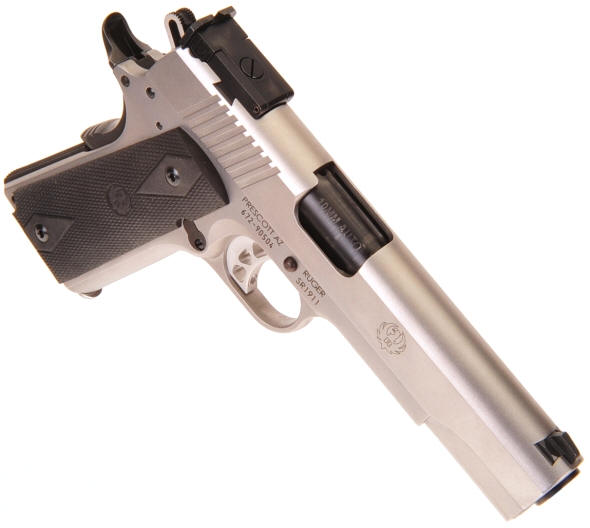
The first 10mm prototype cartridges were fashioned from .30 Remington brass by turning down the cases, cutting a 45° extractor groove and trimming the case to length. Bullets were .41 caliber Sierra 210 grain jacketed flat points, swaged down to .40 caliber. The work was performed and/or managed by John Donnelly, a friend of Jeff Cooper who originated the concept of this heavy combat pistol. If you are not familiar with Mr.Donnelly, amongst other things, he is the author of an invaluable reference book, “Handloader’s Manual of Cartridge Conversions”. 1)
Personal defense…
Having access to a firearm for an extended period of time helps a great deal in its assessment. Putting many rounds through a firearm and punching holes through lots of targets tends to develop a realistic view of a firearm’s potential. After shooting up a good supply of factory ammo through the SR1911 10mm, handloads for personal defense and hunting were next in queue.
The 10mm can easily serve as a personal defense firearm with the right bullet selection. Bullets too light in construction, intended for lower velocity cartridges or target work, run the risk of fragmenting or too rapidly expanding before achieving adequate penetration. Bullets too heavy in construction over penetrate and don’t expand sufficiently.

|
Manufacturer |
Type |
Bullet |
Bullet |
|
|
Speer Gold Dot |
JHP |
155 |
0.547 |
1.250 |
|
Remington Golden Saber |
BJHP |
165 |
0.573 |
1.250 |
|
Remington Golden Saber |
BJHP |
180 |
0.639 |
1.260 |
|
Hornady HP/XTP |
JHP |
200 |
0.682 |
1.260 |
All of the bullets indicated on the table stay together at 10mm Auto velocity levels. The Speer penetrates 12″ in ballistic gel, the 165 grain Golden Saber penetrates approximately 14″ and the 180 grain Golden Saber penetrates 16″. The Speer expands to 0.600″, the 165 Golden Saber expands to 0.700″+ and the 180 grain Golden Saber expands to 0.800″+. All approximate measurements.
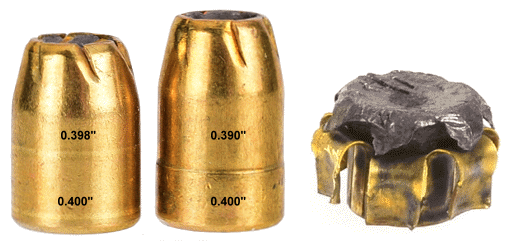
The raised band around the 165 grain shank is 0.225″ high and the 0.400″ diameter is the locating point for the taper crimp. The 180 grain version is a true bore rider; the shorter 0.170″ band is also 0.400″ diameter, groove diameter, but the forward portion of the shank is bore diameter. Both do a good job of reducing bore friction without impairing accuracy.
The 200 grain Hornady penetrated 20″ of ballistic gel and expansion was approx 0.650″. This combination approximates the original concept for the 10mm Auto cartridge, 200 grains at 1200 fps. The 200 grain Hornady fits personal defense applications and it also works as a hunting bullet.
Warning: Bullet selections are specific, and loads are not valid with substitutions of different bullets of the same weight. Variations in bullet material and length will alter net case capacity, pressure and velocity results. Primer selection is specific and primer types are not interchangeable. These data represents maximum loads in our firearms and test equipment and may easily be excessive in other applications. All loads should be reduced by 3%, and developed following safe handloading practices as represented in established reloading manuals produced by component manufacturers. Presentation of these loads does not constitute a solicitation for their use, nor a recommendation.
|
|
||||||||||||||||||||||||||||||||||||||||||||||||||||||||||||||||||||||||||||||||||||||||||||||||||||||||||||||
|
||||||||||||||||||||||||||||||||||||||||||||||||||||||||||||||||||||||||||||||||||||||||||||||||||||||||||||||
Groups are comprised of three 3 shot. As I have always shot 3 shot rifle groups, and statistically there is little gained with 5 shots, I prefer not to burn up ammunition just to be like the other guys. All of the loads presented were easy to manage in terms of recoil and muzzle jump was minor. I would attribute all of this to the added weight and the location of the weight of the SR1911’s bull barrel. No jams or failures to feed were experienced, the slide consistently locked open on empty and the sight adjustment stayed put. No shock to the wrist, no grating of the palm of the shooting hand. No changes were made to the 18 lb factory recoil spring.
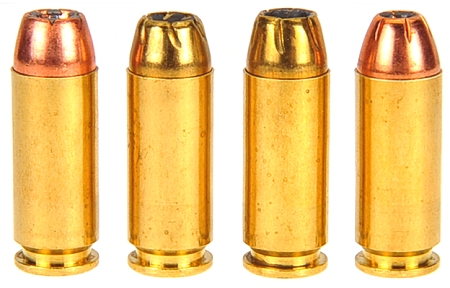
No over the top loads, but surely not light loads. In general, the 10mm Auto can put 200 fps on even exceptionally high performance ammunition for the 40 S&W. As a practical matter, 40 S&W ballistics make for solid personal defense, so why the 10mm Auto? Probably for the same reason there is the 357 Magnum when the 38 Special +P is a pretty decent personal defense round. The 10mm Auto does not have substantially greater recoil than the 40 S&W, but it does offer a significantly greater degree of stopping power.
The 10mm Auto’s power does not come with an extra cost to the handloader. Brass is long lived, powder demands are moderate and even premium bullets are reasonably priced. The 180 grain Golden Saber handload cost was $15/50. 10mm Auto brass runs approximately 20 cents and ten plus reloads is a minimum, so add a $1 and make it $16/50 rounds. Similarly performing 180 grain Buffalo Bore runs $27/20 or $67/50. Federal Premium 180 grain Hydra-Shok $34/20 or $85/50. Don’t ever let anyone tell you there isn’t serious savings and an opportunity to shoot more for less by handloading and to do so with the best components.
Hunting handloads for the Ruger SR1911 10mm…
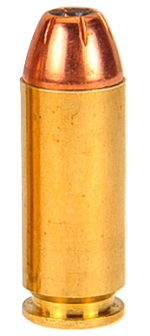 The SR1911 10mm Auto would not be a first choice for Alaskan brown bear hunting. However, until the Discovery Channel offers me a lead role in a new reality show titled, “Old Farts, Reprobates and Other Scoundrels of Alaska”, the chance of me encountering such big and dangerous game is slim to none. In Maine, a more sensible place to live and hunt, male black bears range from 250 to 600 lbs and Maine male moose weight ranges from 1,200 to 1,500 lbs. The Ruger SR1911 10mm Auto is legal for hunting big game in the state of Maine, by cartridge and capacity, where autoloaders with a barrel length of less than 8″ are exempt from the state’s 5+1 capacity restriction.
The SR1911 10mm Auto would not be a first choice for Alaskan brown bear hunting. However, until the Discovery Channel offers me a lead role in a new reality show titled, “Old Farts, Reprobates and Other Scoundrels of Alaska”, the chance of me encountering such big and dangerous game is slim to none. In Maine, a more sensible place to live and hunt, male black bears range from 250 to 600 lbs and Maine male moose weight ranges from 1,200 to 1,500 lbs. The Ruger SR1911 10mm Auto is legal for hunting big game in the state of Maine, by cartridge and capacity, where autoloaders with a barrel length of less than 8″ are exempt from the state’s 5+1 capacity restriction.
Without hesitation, the Ruger SR1911 10mm would make for an excellent primary firearm for deer hunting in this mountainous, tree thatched terrain with mostly short runs of open spaces and shots under fifty yards. With minor reservations, restrictions of range and bullet selection, the Ruger 10mm Auto SR1911 could be used for black bear and moose. Without reservations, the SR1911 10mm Auto makes for a terrific trail gun for anyone who finds themselves spending time hiking, hunting, fishing, and trail blazing Maine’s woodlands.
For folks who like expanding, lead core, copper jacketed bullets, pictured left is a Hornady 200 grain XP/XTP. Another good bullet for hunting applications would be Nosler’s Sporting Handgun Bullet, 200 grain JHP. I am a big fan of cast bullets in handguns, particularly when bore size is substantial… like 10mm/.40 caliber where alloy can be managed to moderate hardness. The Acme bullets selected below are cast from 92-6-2 lead alloy; 92% lead, 2% Tin, 6% Antimony with a Brinell Hardness of 16 which qualifies as hard cast. Unlike hardness derived from heat treating softer lead alloy, these cast bullets are of a consistent hardness throughout. Not so hard as to shatter when striking bone, but hard enough to break bone without fragmenting on impact.
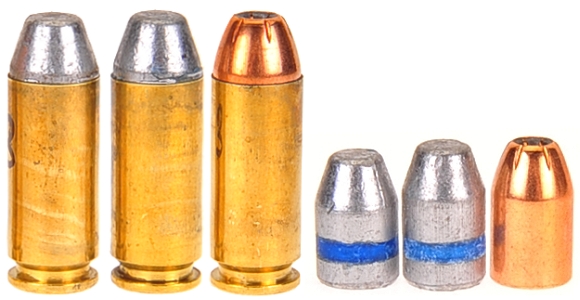
|
Manufacturer |
Type |
Bullet |
Bullet |
|
| Acme Bullet Company |
Cast |
180 |
0.628 |
1.260 |
| Acme Bullet Company |
Cast |
200 |
0.639 |
1.260 |
| Hornady HP/XTP |
JHP |
200 |
0.682 |
1.260 |
Generally, the Hornady 200 grain jacketed hollow point will penetrate 20″ of ballistic gel before coming to a stop, fully expanded. The cast bullets, 180 grain or 200 grain, will blow through 32″ of ballistic gel convincingly and hole punch feral hogs and deer. The reason for their exceptional penetration is a combination of high sectional density and the lack of expansion which carried greater momentum while maintaining a streamlined form. There are many sources of good cast bullets.
Warning: Bullet selections are specific, and loads are not valid with substitutions of different bullets of the same weight. Variations in bullet material and length will alter net case capacity, pressure and velocity results. Primer selection is specific and primer types are not interchangeable. These data represents maximum loads in our firearms and test equipment and may easily be excessive in other applications. All loads should be reduced by 3%, and developed following safe handloading practices as represented in established reloading manuals produced by component manufacturers. Presentation of these loads does not constitute a solicitation for their use, nor a recommendation.
|
|
||||||||||||||||||||||||||||||||||||||||||||||||||||||||||||||||||||||||||||||||||||||||||
|
||||||||||||||||||||||||||||||||||||||||||||||||||||||||||||||||||||||||||||||||||||||||||
The 10mm Auto is a very easy cartridge to handload. Full length size, minimal case mouth expansion and taper crimp. Primers are large pistol, I’ve used both standard and magnum dependent upon powder selection and performance loads are not compressed.
In closing… and I wish that wasn’t so…
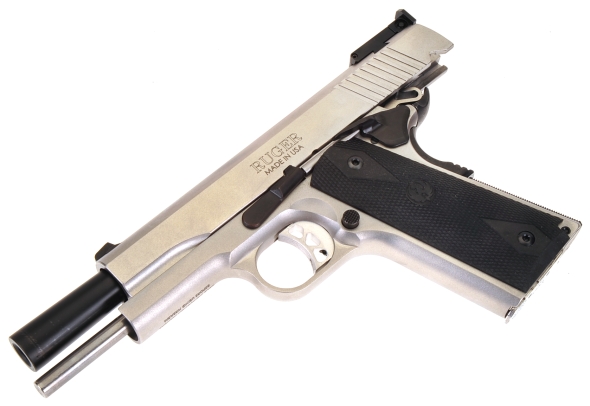
There are numerous 10mm Auto pistols on the market; different designs, different countries of origin and configured for different applications. In this case, Ruger has given something truly useful to 1911 design aficionados; a major boost in power, without overreaching the design, or pandering to market boredom with needless gizmos, gadgets tend to diminish the potential of the design. That is not to say that the Ruger SR1911 is without finesse engineering enhancements that fit well with this combination. Some examples:CNC machining for a close, smooth slide to frame fit
-
Bushingless bull barrel and full length guide rod to dampen recoil
-
Nitride barrel finish and feed ramp for improved feed reliability and wear reduction
-
Series 70 design for a less complex and cleaner trigger
-
Lightweight trigger to abate trigger bounce and provide overtravel adjustment
-
Skeletonized hammer to speed cycling and reduce lock time
-
Extended magazine catch, thumb safety and slide stop for easy, positive actuation
-
Oversize beavertail grip safety to protect and hand an provide positive actuation
-
The plunger tube is integral to the frame and cannot shoot loose
-
Oversize ejection port to assure empty case ejection
-
Barrel tang inspection port permits visual loaded/unloaded chamber check
-
Accepts 1911 standard aftermarket parts and accessories.
Ruger’s SR1911 10MM Auto is consistent with Ruger’s reputation; a U.S. made product of superior quality and reliability, destined to provide many years of exceptional service.

Email Notification